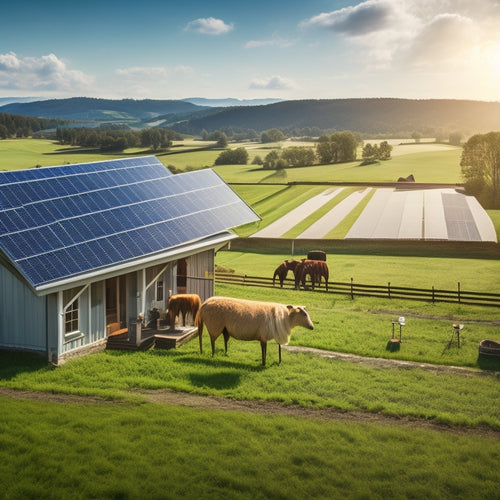
What Accessories Do I Need for Flat Roofs?
Share
When it comes to flat roofs, you'll need to assess a range of accessories to guarantee a safe and efficient installation. Start by evaluating your mounting system requirements, including structural integrity and wind resistance. You'll also need to select suitable roof anchors and clamps, and implement waterproofing and sealing measures. Don't overlook electrical connectors and fuses, monitoring and tracking devices, and flashing design considerations. Additionally, you'll need cable management systems and ballast and racking options. As you explore these components, you'll uncover more nuances to secure a successful installation - and a deeper understanding of each accessory's role.
Key Takeaways
• Ensure waterproofing and sealing with membrane protection systems and regular maintenance to prevent water ingress.
• Choose suitable roof anchors and clamps that meet load capacity standards and consider fall protection and roof safety.
• Select compatible flashing designs that integrate seamlessly with the roof membrane and schedule regular inspections.
• Implement cable management systems to maintain roof integrity, reduce damage risks, and ensure safe access for maintenance.
• Consider ballast and racking options that securely fasten PV systems, distribute weight evenly, and resist corrosion.
Mounting System Requirements
When designing a mounting system for your flat roof, you must take into account the structural integrity of the roof deck, bearing in mind factors such as load calculations, wind resistance, and roof drainage. This is vital to guarantee the safety and durability of your roof. You can't just slap on any old mounting system; you need to carefully evaluate the weight and pressure it will put on your roof.
Load calculations are an essential component of this process. You'll need to determine the maximum weight your roof can support, considering the weight of the mounting system, any additional components, and even the weight of people who may be walking on the roof.
You'll also need to take into account environmental factors, such as high winds or heavy snowfall, which can add extra stress to your roof. By carefully assessing these factors, you can design a mounting system that meets your needs while also ensuring the structural integrity of your roof.
Roof Anchors and Clamps
As you specify roof anchors and clamps for your flat roof project, you'll need to take into account the type of anchor that's suitable for your roof's specific conditions.
You'll want to choose from a range of anchor types, including permanent, temporary, and removable options, each with its own advantages and limitations.
Types of Anchors
You'll need to select from a range of anchors, including permanent, reusable, and disposable options, to guarantee your rooftop equipment is securely fastened. The type of anchor you choose will depend on your specific needs and the type of equipment you're using. Permanent anchors are ideal for frequent use, while reusable anchors offer flexibility and convenience. Disposable anchors, on the other hand, are a cost-effective option for one-time use.
Here's a breakdown of the different types of anchors:
| Anchor Type | Description |
|---|---|
| Permanent | Ideal for frequent use, providing a secure and permanent attachment point |
| Reusable | Offers flexibility and convenience, allowing for easy removal and reattachment |
| Disposable | Cost-effective option for one-time use, reducing waste and minimizing environmental impact |
| Temporary | Provides a secure attachment point for short-term use, ideal for maintenance and repair |
When selecting an anchor, consider factors such as fall protection and roof safety. Make sure that your chosen anchor meets or exceeds industry standards for load capacity and durability. By picking the right anchor, you can ensure a safe and secure working environment on your flat roof.
Anchoring Methods
To guarantee a secure attachment, you'll need to choose the right anchoring method, which involves selecting from a range of roof anchors and clamps that are designed to work in tandem with your chosen anchor type. The anchoring method you choose will depend on the type of anchor you're using, as well as the specific requirements of your flat roof.
When selecting an anchoring method, it's crucial to take into account factors such as wind resistance and compliance with anchoring codes. Here are some key considerations to keep in mind:
-
Anchoring codes: Make sure that your chosen anchoring method meets local building codes and regulations.
-
Wind resistance: Opt for an anchoring method that can withstand high winds and extreme weather conditions.
-
Roof type: Choose an anchoring method that's compatible with your flat roof's material and construction.
- Load calculation: Calculate the maximum weight capacity of your anchor and ensure it can support the weight of the equipment or personnel.
Waterproofing and Sealing
When you're working with flat roofs, you understand that waterproofing and sealing are critical components of the overall system.
You'll want to contemplate membrane protection systems, coatings, and sealants to guarantee a watertight seal.
Membrane Protection Systems
Membrane protection systems, comprising waterproofing and sealing, are designed to prevent water infiltration and damage to your flat roof's membrane. As a building owner, you understand the importance of safeguarding your roof from water damage. A membrane protection system is an essential accessory for your flat roof, ensuring the longevity of your roofing system.
To guarantee the effectiveness of your membrane protection system, you should:
- Regularly inspect your membrane for signs of damage or wear
- Perform routine maintenance tasks, such as cleaning and repairing damaged areas
- Ensure all seams and joints are properly sealed to prevent water infiltration
- Implement a regular maintenance schedule to prevent unexpected issues
Coatings and Sealants
How do you guarantee your flat roof's waterproofing and sealing systems are up to par, given the constant exposure to the elements? The answer lies in the application of high-quality coatings and sealants. These essential accessories not only protect your roof from water ingress but also extend its lifespan.
You'll want to choose coatings that can withstand harsh weather conditions, UV rays, and extreme temperatures. Look for products that have undergone rigorous adhesion tests to make sure they bond well with your roof's substrate.
In addition to coatings, don't overlook the importance of moisture barriers. These thin, impermeable layers prevent water from seeping into your roof's substrate, causing damage and decay. When selecting a moisture barrier, consider factors like permeability, durability, and compatibility with your roof's materials.
Electrical Connectors and Fuses
You'll rely on electrical connectors and fuses to safeguard your flat roof's electrical systems from power surges and shorts. These accessories are essential in preventing electrical malfunctions that can lead to costly repairs, downtime, or even safety risks.
When selecting electrical connectors, consider the type of electrical system you have, the voltage requirements, and the environmental conditions your roof will be exposed to.
To guarantee your flat roof's electrical systems operate within safe parameters, you'll need:
- Voltage regulators to stabilize voltage fluctuations
- Circuit breakers to automatically disconnect power in case of an overload
- Fuses with specific ampere ratings to protect against excessive current
- Weather-resistant connectors designed to withstand harsh outdoor conditions
Monitoring and Tracking Devices
As you safeguard the electrical systems on your flat roof, shift your focus to monitoring and tracking devices that offer real-time insights into your roof's performance and alert you to potential issues before they escalate.
These devices empower you to take proactive measures, ensuring your roof remains secure and efficient. You'll want to invest in sensors that track temperature, humidity, and pressure, providing essential data to optimize your roof's performance.
Regular sensor calibration is important to guarantee accurate readings, allowing you to make informed decisions. Additionally, integrate weather forecasting tools to anticipate and prepare for extreme weather conditions.
This fusion of real-time monitoring and predictive analytics enables you to respond promptly to potential issues, mitigating damage and reducing maintenance costs. By doing so, you'll enjoy enhanced peace of mind, knowing your flat roof is performing at its best.
Roof Penetration Flashing
Properly installed roof penetration flashing is crucial to preventing water infiltration around vents, pipes, and other roof-mounted equipment on your flat roof. When it comes to designing and installing flashing systems, you'll want to take into account the type of equipment being installed, as well as the roof's slope, material, and climate.
To guarantee a watertight seal, take into consideration the following key factors for your flashing design:
-
Flashing materials: Select materials that are compatible with your roof's membrane and can withstand harsh environmental conditions.
-
Flashing designs: Opt for custom designs that consider the specific equipment being installed, ensuring a precise fit and minimizing the risk of water ingress.
-
Seamless integration: Ensure that the flashing system is fully integrated with the roof membrane, eliminating any gaps or weaknesses.
- Regular inspections: Schedule regular inspections to identify and address any potential issues before they become major problems.
Cable Management Systems
Effective cable management systems play an essential role in maintaining the integrity of your flat roof by organizing and securing cables and wires, thereby reducing the risk of damage to the roof membrane and ensuring safe, easy access for maintenance and repairs. A well-designed cable management system keeps your roof clutter-free, allowing you to identify and address potential issues quickly.
When selecting a cable management system, consider one that prioritizes cable concealment and wire organization. This will help minimize the risk of damage from UV exposure, weathering, and physical stress. A good system should also allow for easy cable routing and re-routing, making it easier to add or remove cables as needed.
Ballast and Racking Options
You'll need to take into account ballast and racking options that assure your flat roof's photovoltaic (PV) systems or solar panels are securely fastened to withstand various environmental conditions. The ballast weight and racking design you choose will have a significant impact on the overall performance and longevity of your solar installation.
When selecting a ballast and racking system, consider the following key factors:
-
Weight distribution: Assure the ballast weight is evenly distributed across the roof to prevent damage and ensure stability.
-
Structural integrity: Choose a racking design that can withstand wind, snow, and other environmental loads.
-
Adjustability: Opt for a system that allows for easy adjustments to accommodate different roof angles and panel configurations.
- Material durability: Select materials that can resist corrosion and degradation over time, such as anodized aluminum or stainless steel.
Frequently Asked Questions
Can Flat Roof Accessories Be Used on Pitched Roofs?
"Absence of evidence doesn't mean evidence of absence." When considering roof compatibility, you'll find that flat roof accessories aren't typically designed for pitched roofs, limiting design flexibility, so it's best to choose accessories specifically designed for your roof type.
How Often Should I Inspect My Flat Roof Accessories?
You should inspect your flat roof accessories regularly, ideally during seasonal checks, to check your roof's condition and prevent damage; prioritize safety precautions to avoid hazards, guaranteeing your roof remains secure and efficient.
Are All Flat Roof Accessories Uv-Resistant?
"Did you know 70% of flat roofs fail due to material degradation? You'll be relieved to know that reputable manufacturers subject their accessories to rigorous weather testing, ensuring UV-resistance and material durability for your peace of mind."
Can I Install Flat Roof Accessories Myself?
You can install flat roof accessories yourself, but be mindful of your DIY fears and guarantee compliance with local regulations, as improper installation can lead to costly consequences and compromise your roof's integrity.
Do Flat Roof Accessories Come With Warranties?
When you invest in flat roof accessories, you're not just buying a product, you're buying peace of mind - and that's exactly what a solid warranty provides. Expect manufacturer support with warranty periods ranging from 10 to 30 years.
Related Posts
-

Off-Grid Solar Solutions for Sustainable Farming
Off-grid solar solutions can revolutionize your farming operations by providing energy independence and significant c...
-

Solar Power Savings for Environmentally Aware Consumers
Switching to solar power lets you drastically cut your carbon footprint while saving money in the long run. Each kilo...
-

Solar Power Systems for Rural Properties
Solar power systems offer a reliable and efficient energy solution for rural properties, allowing you to gain energy ...


